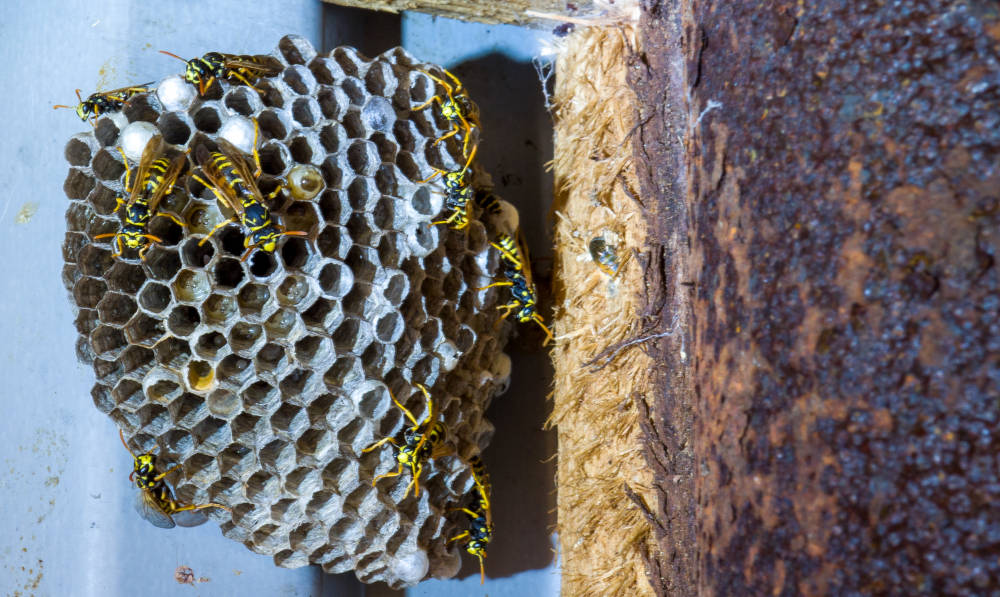KEY TAKEAWAYS:
Identify and Assess: Determine the type of wasps and the location and size of the nest before taking any action.
Protective Gear: Always wear protective clothing, including long sleeves, gloves, and a hat with netting, to minimize the risk of stings.
Optimal Timing: Remove the nest at night or early morning when wasps are less active.
Effective Insecticide Use: Use a wasp-specific insecticide spray to thoroughly saturate the nest from a safe distance.
Prevent Future Nests: Seal entry points, remove food sources, and regularly inspect your property to prevent future infestations.
Discovering a wasp nest on your property can be an unsettling experience.
Wasps can be aggressive, especially when their nest is disturbed, and their stings can be painful and even dangerous to those with allergies. However, with the right precautions and methods, you can safely remove a wasp nest.
Here’s a comprehensive guide to help you through the process.
Step 1: Assess the Situation
Before taking any action, it’s crucial to identify the type of wasps and the location of the nest. Common types include yellow jackets, paper wasps, and hornets. Each has different levels of aggression and nest structures.
Yellow Jackets: Typically build nests in the ground or inside walls.
Paper Wasps: Create open, umbrella-shaped nests usually found under eaves or in attics.
Hornets: Build large, enclosed nests often found in trees or shrubs.
Evaluate the size of the nest and the level of wasp activity. If the nest is large or the wasps are highly active, consider professional help.
Step 2: Gather Necessary Equipment
For a safe removal process, you will need the following:
Protective clothing: Long sleeves, pants, gloves, and a hat with a veil or netting.
Flashlight: If removing the nest at night.
Insecticide spray: Specifically designed for wasps.
Plastic bag: For nest disposal.
Long stick or pole (optional): To knock down the nest if it’s small and reachable.
Step 3: Choose the Right Time
Wasps are less active during the night and early morning when temperatures are cooler. This is the safest time to approach the nest.
Make sure to wear protective clothing to minimize the risk of stings.
Step 4: Apply Insecticide
Use a wasp-specific insecticide spray that can reach the nest from a distance of at least 15-20 feet.
Follow these steps:
Stand at a Safe Distance: Position yourself as far from the nest as possible while still being able to aim the spray accurately.
Spray the Nest Thoroughly: Direct the spray at the entrance of the nest to target the wasps inside. Continue spraying until the nest is saturated.
Wait and Observe: After spraying, leave the area immediately. Wait for at least 24 hours to ensure all wasps are dead.
Step 5: Remove the Nest
Once you are confident that the wasps have been eradicated, it’s time to remove the nest:
Wear Protective Clothing: Even if the wasps appear to be dead, wear protective clothing to prevent any potential stings.
Knock Down the Nest: Use a long stick or pole to knock the nest down if it’s in a reachable location.
Dispose of the Nest: Place the nest in a plastic bag and seal it tightly. Dispose of the bag in a trash bin away from your home.
Step 6: Prevent Future Infestations
To avoid future wasp problems, take preventive measures:
Seal Entry Points: Inspect your home for cracks and crevices that wasps could use to enter. Seal these with caulk or another appropriate material.
Remove Food Sources: Keep outdoor food and trash covered to avoid attracting wasps.
Regular Inspections: Regularly check your property for early signs of nest building, especially in spring when wasps are most active in nest construction.
When to Call a Professional
If the nest is large, difficult to access, or if you are allergic to wasp stings, it’s best to hire a professional pest control service.
Professionals have the experience and equipment to handle wasp nests safely and effectively.
Summary
Removing a wasp nest can be a daunting task, but with the right approach and safety measures, it can be done effectively. Always prioritize your safety and consider professional help when necessary.
By following these steps, you can protect your property and enjoy a wasp-free environment.

